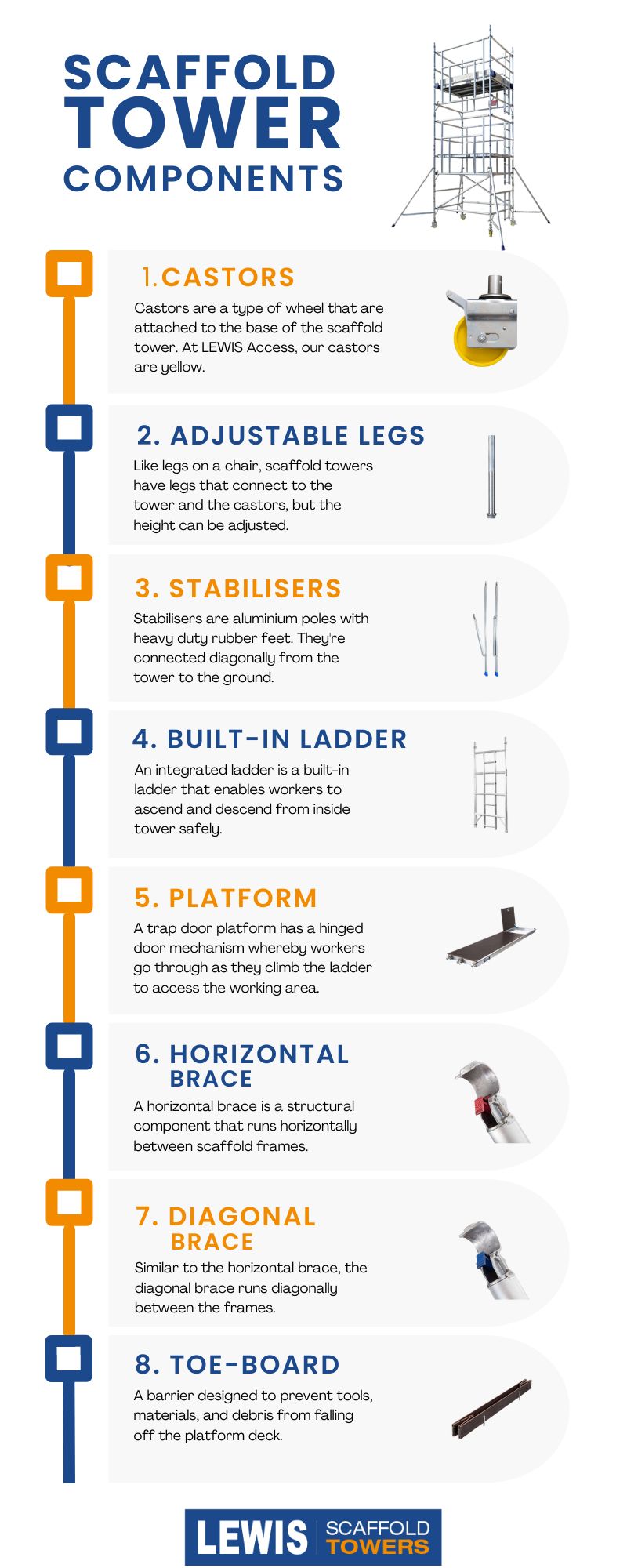Are you in the process of buying access equipment? It’s important to familiarise yourself with the components, especially scaffold tower components.
If you’ve ordered a scaffold tower from a supplier that doesn’t provide all of the components, it’ll be unsafe to use and could result in hefty fines. Therefore, delaying any project or job where it’s required.
Unfortunately, it happens quite often. But, fortunately for you, you’re taking the right steps by reading this article produced by LEWIS Access. We’re the UK’s leading scaffold tower manufacturer; we supply all of the components to keep your jobs and projects on schedule.
Scaffold Tower Components
Castors
What are castors?
Castors are a type of wheel that are attached to the base of the scaffold tower. At LEWIS Access, our castors are yellow.
What is the purpose of castors?
Castors make it easy for operatives to push the scaffold tower to a different location. In turns, it saves time by preventing the need to disassemble and reassemble and reduces the risks of the scaffold tower being disassembled and reassembled incorrectly.
However, it’s still important to ensure that the path is safe to free from obstructions on the ground and overhead. We wrote a detailed blog and shared an infographic on scaffold tower safety tips, which we recommend you read.
What are the features of castors?
Locking Mechanism
BSEN1004-compliant like the scaffold towers we manufacturer at LEWIS Access, have a locking mechanism. This is paramount to secure the scaffold tower in place on the ground to ensure it’s stable and safe for workers to climb up the ladder on the inside of the tower.
Load Capacity
A scaffold tower that’s BSEN1004-compliant supplied by a reputable manufacturer or supplier will effectively bear the weight of the scaffold tower and up to the maximum load weight. At LEWIS Access, we manufacture ours with aluminium and heavy duty rubber.
Durability
We’re all too familiar with phrase “buy cheap, buy twice”. It couldn’t be more true when it comes to scaffold towers and spare parts. Castors must be resistant to wear and tear and corrosion, ensuring that it remains as safe as possible for as a long as possible. However, it may eventually happen, in which case, you should only buy spare parts from the manufacturer.
Adjustability
The final feature you should be aware of when purchasing a scaffold tower is whether it comes equipped with adjustable legs. At LEWIS Access, all our scaffolding towers include adjustable legs, which will explain in more detail below.
Adjustable Legs
Like legs on a chair, scaffold towers have legs that connect to the tower and the castors, but the height can be adjusted.
What is the purpose of adjustable legs?
When the ground where the scaffold tower will be used is slightly uneven, adjustable legs allow the assembler to adjust the height to level the platform. It’s important to note here that they must not be used to help the tower gain additional height.
What are the features of adjustable legs?
Threaded Adjustment Mechanism
At LEWIS Access, our adjustable legs use a threaded mechanism. This allows precise height adjustments when twisting the rod to raise or reduce height of one, two or three legs.
Locking Mechanism
It’s important to check that the adjustable legs on the scaffold tower you intend to purchase have a locking mechanism. This will secure the leg at the desired height. It’s often pins, clamps, or locking nuts that prevent the leg from moving once it’s set by the assembler.
Stabilisers
Stabilisers are aluminium poles with heavy duty rubber feet. They’re connected diagonally from the tower to the ground.
What is the purpose of stabilisers?
Stabilisers increase the footprint of the tower, which significantly reduces the risk of toppling over as the weight is evenly distributed. Depending on the height and width of the scaffold tower your purchase, you’ll either be supplied with no stabilisers, standard or jumbo stabilisers.
Integrated Ladder
An integrated ladder is a built-in ladder that enables workers to ascend and descend from inside tower safely.
What is the main feature of an integrated ladder?
Non-Slip Twist-Proof Rungs
Ladder rungs are the bars that workers place their feet to climb up and down the tower. At LEWIS Access, our rungs are non-slip and twist-proof, which makes using the integrated ladder safe to use. Some manufacturers and suppliers only provide non-slip rungs.
Trap Door Platform
The platform deck is the working area; a trap door platform is the same with a hinged door mechanism whereby workers go through as they climb the ladder. It prevents workers from going around the platform on the outside of the frame.
What are the features of a trap door platform?
Hinged Door
A section of the platform is hinged to open and close easily, often equipped with a latch or lock to secure it when closed.
Durable Construction
Made from aluminium, designed to support the maximum load weight.
Non-Slip Surface
Platforms and trap door must have a non-slip surface to prevents slips while working at height. Non-slip shoes are still an essential personal protective piece of equipment.
Horizontal Brace
A horizontal brace is a structural component that runs horizontally between scaffold frames.
What is the purpose of a horizontal brace?
Its primary purpose is to improve the stability and rigidity of the scaffold structure by providing support and maintaining the correct spacing between the frames.
Diagonal Brace
Similar to the horizontal brace, the diagonal brace runs diagonally between the frames.
What is the purpose of a diagonal brace?
It serves serval purposes, including structural stability, load distribution and prevents the tower from twisting.
Toe-board Set
A toe-board is a safety feature that’s installed along the edges of the working platform. It’s effectively a low, vertical barrier designed to prevent tools, materials, and debris from falling off the platform, thereby protecting workers and members f the public from potential falling hazards.
Summary
In summary, there are several considerations when purchasing a scaffold tower, but first and foremost, you must ensure that the manufacturer or supplier includes all of the components required. When buying from LEWIS Access, you can rest assured that all components are made to British quality, and supplied when you purchase. Should you require any assistance, our well-trained team are here to take your calls or answer any live chat messages.


